
 A pilot study into interactive music systems for distraction and play techniques for adolescents
A pilot study into interactive music systems for distraction and play techniques for adolescents
— University of Western Sydney
Abstract
This project aims to create an exciting and stimulating play device for hospital patients, specifically for teenagers (12-18+) with the main objective being entertainment and distraction through interactive play and music making. This will be achieved through an interactive digital music installation that engages audio and visual stimulation and will be referred to as the Music Cubes. The role of the Music Cubes is to enhance interactive play that is not evident in distraction techniques currently provided to teenagers within the Department of Adolescent Medicine at The Children’s Hospital at Westmead.
The hypothesis is that integrating the use of computers into therapeutic practices such as play therapy, could be the key to positively engaging and motivating adolescents. There is no doubt that most young people enjoy using computers. Technology is on the rise, and the relationship between computer and human-integration is becoming more prominent. This research reveals a prominent gap in the field of therapeutic interactive play and seeks to explore possible solutions to this issue through use of the Music Cubes.
The challenge for this project is that there is no direct answer. The creative work therefore, draws on a range of different disciplines such as play as a therapeutic tool, music, interactive digital technologies, design considerations, and an examination of literature to determine how to proceed with implementing and building the device. The Music Cubes seeks to offer innovative stimulation through play and music making within a hospital environment to act as entertainment and distraction.
Introduction
The inspiration for this project stems from personal frustration: seeing my 18-year-old brother constantly in and out of the hospital for many years repeatedly in a vulnerable and dismal predicament. While the hospital staff and doctors fulfilled their jobs as health professionals, for a teenager who is shut off from the outside world, from their social life and normal routine, life couldn’t be more boring. Visiting my brother in hospital, my time was spent trying to occupy and stimulate him through conversation, board games and watching T.V. But after doing this for so many hours the options soon run out. During these hospital visits, I noticed the coldness of the atmosphere, lack of colour, and a desperate need for stimulation.
In my experience, adolescents within Sydney hospitals often don’t have a place to call their own – something that might be viewed as a fundamental need for a person with unruly hormones. As they are either thrust into a children’s ward or adult’s ward, hospital time for adolescents could not be considered fun. One could argue that as a teenage is at an age of growing independence, they should be able to handle the experience. However, being in a hospital and missing school, friends, parties, soccer games and the routine of normal teenage life, means that the days and hours pass slowly. The purpose behind the Music Cubes is to help this situation. An interactive music-making device will allow will teenagers not only to have a device with which to play, interact and socialise, but will provide a tool for entertainment and distraction, however small it may be, to call their own.
This project, called the Music Cubes, aims to create an exciting and stimulating play device for a hospital, specifically for teenagers (12-18+). Its purpose is to distract and entertain patients in the foreign surroundings of a hospital by engaging in interactive music making via a computer device. The hypothesis is that integrating the use of computers into therapeutic practices such as play and distraction, could be the key to positively engaging and motivating adolescents. There is no doubt that most young people enjoy using computers, Technology is on the rise and the relationship between computer and human integration is becoming more prominent.
The most enjoyable experiences with my brother often involved listening to our favorite music, guessing the lyrics to come, and bathing in the comfort of familiar songs. It is amazing what music can do to the body and soul. Even looking back through my HSC, I used to plug in my earphones for an hour a day, zone out and de-stress. Some may call this anti-social, but for me it was a distraction from the information floating about in my brain from the school day. So far we can quantify some of the emotional responses caused by music, but we cannot yet explain them. But that's okay. I don't have to understand electricity to benefit from light when I switch on a lamp when entering a room, and I don't have to understand why music can make me feel better emotionally. For children and teenagers music is a part of everyday life. Learning through music is becoming increasingly popular. Look at The Wiggles who have sold 17 million videos and 5 million CDs, countless toys, clothing and books (Urban, 2005).
The Music Cubes will seek to give adolescents an opportunity to engage with an innovative device encouraging play and exploration with creative outcomes in a predictable, controllable and safe environment in order to distract them from any daunting fears they may be facing. The hope is that the Music Cubes will contribute to the wellbeing of patients through distraction and interactive play in both an individual and group contexts.
The challenge of this project is that there is no direct answer. The construction around the Music Cubes therefore, draws on a range of different disciplines such as play as a therapeutic tool, music, interactive digital technologies, design considerations, and an examination of literature to determine how to proceed with implementing and building the device. It is important to note that the interactive play space is not an experiment; it does not seek to have a specific outcome like that of most of the interactive music and play projects used within therapeutic environments such as Play and Music Therapy. It also does not seek to replace or reproduce the relationship between employed therapists, but rather the play space seeks to offer innovative stimulation through play and music making within a hospital environment to act as a distraction.
Key Issues
The project can be broken up into key issues, which are:
Play and Music
Play in the hospital environment aims to provide experiences that distract children and it also helps prepare them for medical procedures. In the majority of major hospitals, play therapists are employed to oversee play activities and play areas aimed at children and adolescents. Their primary role is to facilitate play activities that promote wellbeing and normalise a patient’s stay (N Anderson, 2010). Music therapists are also employed in hospitals to facilitate clinical analysis through music activities. Music is ubiquitous in modern society and so therefore it is a medium that is likely to engage a wide audience. However, it is important to note here that the play device (The Music Cubes) does not act to replicate the role of the music or play therapist but rather to employ therapeutic practices to distract the patient through music making and interactive play activities.
Distraction Techniques
Distraction techniques are important in a clinical environment and using the combination of play and music may be beneficial in helping a patient adapt, relax and become familiar with the foreign surroundings of a hospital. The play therapists often implement certain play activities to suit certain age groups. There is a wide range of activities, as can be seen in
Table 1 illustrates a collection of distraction techniques and methods for certain age groups that may be used within a hospital environment. In the 12-18+ category, it is evident that play therapists use methods and distractions that are already available to patients in their everyday lives and therefore do not constitute for “special” activities in the same manner as the activities offered to younger age groups. This has led me to build the play devices specifically for the 12-18+ age group in order to bridge the gap in engaging teenagers in innovative stimulation and distraction.
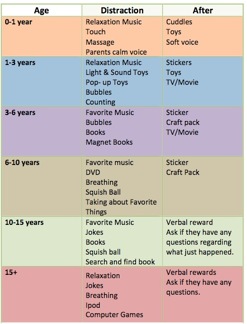
Interactive digital technologies
The potential of electronic toys for use in medical settings has been of interest in the hospital environment for some time. Recreational therapists from Sydney’s Royal Rehabilitation Centre for example, use Wii Motes on burns victims to help distract the patient and encourage physical movement through interactive games (Stack Games, 2009).
There is a growing demand for play and music therapists to apply similar interactive technologies in clinical practices. There are many new interfaces and computer devices that are being created that can incorporate art, music, play and technology within one model. Application to the hospital environment is merely scratching the surface of an incredible, adaptable and beneficial tool. These tools include Play Stations (Sony Computer Entertainment, 2010) and iPods (Apple Inc, 2010). Technology is limited only by our imaginations, which can sometimes be intimidating (to those who don't understand it), but also has the potential for social, mental and in some cases physical therapies. In the future, technology could be integrated with existing play tools to support educational, therapeutic, and assessment outcomes in the areas of communication, social and self-esteem development. This project proposes a solution, if merely a small one, towards the lack of innovative stimulation for teenage patients of the Adolescent Medicine Department at The Children’s Hospital Westmead.
Presently, the technology available for play purposes to patients within the Adolescent Medical Unit at The Children’s Hospital Westmead is limited. This includes devices such as iPods and Play Stations. These devices often promote reclusive activities (N Anderson, 2010). The objective of the department is to normalise the patient’s stay and make them feel at home. This includes encouraging socialisation and group activities (Anderson, 2010). This objective is difficult with the available interactive technologies mentioned above, however, as most are designed for one user. The Music Cubes can be used for both the independent user and group users through different music settings.
Play – its importance to the young
Play has been defined as activities that are exploratory in nature and consist of a variety of activities that involve movement and manipulation in relation to the environment (Stagnitti, 2004). Traditionally, the ‘tools of the trade’ for child life specialists have been paint, clay, ceramics, textiles, collage materials, three-dimensional toys and music. However within the last two decades, clinical programs have begun to introduce technology as a therapeutic medium for hospitalised children and families to offer new forms of stimulation (D Rode, K Capitulo, M Fishman, & G Holden, 1998). This can be seen in the use of Play Stations (Sony Computer Entertainment, 2010) and other gaming devices that could now be considered common devices used for distraction.
In a hospital context, play therapist Estreich (Estreich, 2010) points out that play is important in distracting patients during potentially distressing procedures. The most important information retrieved from personal email correspondence with Estreich was distraction techniques as can be seen in Table 1 . The chart shows different play methods and devices used for specific age groups. In the 10-15 and 15+ categories of Table 1 it is evident that play therapists use methods and distractions that are already available to patients in their everyday lives, and therefore do not constitute for “special” activities in the same manner as the activities offered to younger age groups.
It is evident through the distraction techniques provided by Estreich, that stimulation approaches for adolescents are lacking. Often the techniques used are within their known experience, such as iPods and computer games, confirming that the adolescent’s place within the hospital is mostly overlooked. Estreich points out that the reason for this may be that the 12-18 age group is often hard to cater for (2010,). This is not necessarily to say that they are not stimulated, but as far as providing resources, they don't have as wild a selection of possible diversionary activities as the younger children (et.al, 2010). For this reason the Music Cubes have been specifically targeted towards the 12-18 age group in order to bridge the gap in engaging teenagers in innovative stimulation and distraction through the use of interactive digital technology.
One of the main goals of using music and play in this hospital context is to try to relieve the anxiety and pain children and adolescents suffer as a result of the intrusive procedures to which they are subjected (C Preti & G Welch, 2004). Activities such as arts, crafts, computer gaming and the like are employed in the hospital environments to help normalise the patient’s stay within hospital (N Anderson, 2010). For teenagers especially, integrating the use of computers into practices such as play could be a key to positive engagement and motivation. A Schools Physical Activity and Nutrition Survey (Health NSW, 2004) shows that:
- Among 11– 14-year olds, three-quarters have a television in their bedroom
- Two-thirds have their own DVD player or video recorder
- One-quarter have a computer in their bedroom
- Two-thirds play computer games in their rooms
- Boys spent up to 18–22 hours a week in front of a screen, which was 3–5 hours more than girls
In 2005, Yahoo! and Media Communications conducted a worldwide study of the use of media and technology by young people from the ages of 18-22 (Yahoo!, 2005). The report ranked the top 10 countries according to their use of electronic media. Within the top 10 countries, Australia was ranked:
- 1st - Text messaging (97%)
- 2nd - Own or regularly use video game consoles (61%)
- 2nd - Use email (85%)
- 3rd - Own or regularly use Personal Computers (88%)
- 3rd - Own or regularly use mobile phones (92%)
- 3rd - Use instant messaging (85%)
- 3rd - Use games on mobile phones (74%)
It can be concluded from the statistics above that the application of digital technologies to provide interactive music making experiences as distraction, is, therefore, a logical step.
Teenagers – activities available to patients
The organisation that most commonly facilitates and promotes play within Sydney hospitals is the Starlight Children’s Foundation. The Starlight Children’s Foundation runs numerous programs within Australian hospitals such as The Starlight Express Room (Westmead Children's Hospital, 2010). Club Ado is the most relevant of the Starlight Children’s Foundation initiatives as it gives hospitalized teenagers a dedicated space of their own, including exclusive access to a games room, cafe, arts area, media studio and lounge. Only teenagers 12- 19 are allowed in the space, as opposed to the Starlight Express Room that is primarily available for children 12 and under. This initiative is however, only operating within Princess Margaret Hospital, Perth, where the Starlight Express Room (12 under) is employed in most major hospitals within Australia (The Starlight Children's Foundation, 2010).
Club Ado is useful in offering teenagers a place of their own to feel comfortable, play pool and video games. Club Ado covers the issues of ‘a place to call their own’, however limited that may be. It may be considered by some that adolescents ‘know about everything’ and therefore, nothing is new to them, so no real effort is made to make an environment that is stimulating/distractive. This could be why Club Ado is only operational within the Princess Margaret Hospital, Perth and not in other hospitals nationwide ( The Starlight Children’s Foundation, 2010).
Other initiatives include Youth Art, which is a creative arts program for adolescents, aged 12-18. The aim of the program is to create, have fun, and mix with other adolescents while taking ‘time out’ from illness. The objective of the programs and activities available to patients is to connect them to their creative selves through activities such as photography, ceramics, sculpture, drawing and painting, printmaking and craft, and the general promotion of wellbeing (N Anderson, 2010).
In 2008, one of many group arts activity was initiated by the Youth Arts Program within the Department of Adolescent Medicine called Teenscape: A Backyard Odyssey (The Department of Adolescent Medicine, 2008) as can be seen in Figure 1 . As mentioned earlier the patients have activities within this existing ward to occupy their time, but none involve interactive music making devices like the Music Cubes.

Currently the programs mentioned above do not offer digital stimulation like the Music Cubes. However, they are looking to expand their entertainment and distraction activities, so the Music Cubes have been designed specifically for the Department of Adolescent Medicine to meet the needs of their patients. The issues above address the need for a project that offers innovative and interactive stimulation that is different to everyday activities for adolescents. The Music Cubes seeks to fulfill this gap.
The argument against the use of digital instruments within a hospital environment.
The potential for digital instruments within the therapeutic environment could assist patients in innovative expression and distraction as it allows a wider palette of musical expression, and enhances the user’s experience of music interaction as well as their ability to interact with others. This is an objective that traditional musical instruments (such as guitar and piano) do not allow, as they are fixed instruments, and users who have minimal or limited movements (such as physical disabilities) might find this difficult to use. However, the reluctance to use new technology in therapeutic practice is still prominent as some traditionally trained musicians can be left uninspired by the use of computers in music (T. Magnusson & E Mendieta, 2007).
The argument for digital instruments within a hospital environment.
Electronic play has the potential to be entertaining without the clinician’s facilitation in naturally occurring, normative play experiences. Studies have shown that electronic play may also contribute positively in the contexts of physiotherapy, occupational therapy, pain management, facilitating the development of social skills in children and adolescents with learning disabilities, mental retardation, and autism spectrum disorders (D Salonius-Pasternak & H Gelfond, 2005).
Garth Paine (2009) argues that computer interaction has the same potential as acoustic instruments, but is not understood by most users. Paine explains that “[p]hysical and musical gestures can be accommodated in digital instrument design, that it can even go a step further and defy the limits of human body and encourage limitless expression capabilities and outcomes.” (Paine, pg 2, 2009). This can also offer new possibilities and outcomes for patients who may be disabled, whereas acoustic instruments are fixed physically. An example of an interactive music making device that facilitates play and distraction is a device known as Movement to Music. MTM (C Tam, H Schwellnus, C Eaton, Y Hamdani, & A Lamont T Chau, 2007) was created to offer alternatives to the known form of stimulation, that is switch-operated toys that only provide cause-and-effect type experiences. MTM incorporates automatic movement recognition technology that is non-contact and non-invasive, as can be seen in Figure 2 . When the child moves a part of his or her body into the space occupied by a virtual shape, a musical tone is triggered. It offers a new opportunity for able-bodied and disabled persons to participate in play whilst also improving psychosocial skills, and body function.
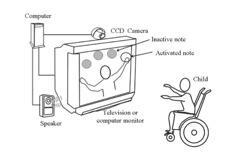
Design Considerations
Design considerations are important when considering building an interactive music device. The goal of the design of a new digital instrument is to be musically expressive through the use of advanced technology. However, as mentioned by Paine, digital instruments have the ability to resolve some of the issues that faced the fixed qualities of the acoustic instrument (Paine G, 2009).
To build digital instruments successfully two general qualities that form the relationship between the user and the device need to be taken into consideration. These, as established by Paine, are physical and musical parameters, as can be seen in Table 2 . These parameters are taken from acoustic instruments and could be considered successful and transferable to digital technologies and instrument design and, therefore, are fundamental in order to build stimulating instruments for teenagers within a hospital environment (et.al, 2009).
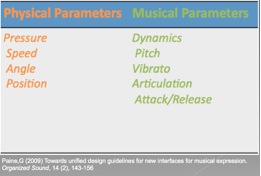
The main differences between the acoustic and digital instruments found within Burland’s Study, as can be seen in Table 3 and Table 4 (Magee W & Burland K 2008), were that the digital instrument was useful as it can be created for specific needs, whereas the player has to “mould oneself” to the acoustic instrument. However, there was much discontent with the uncertainty of the continuation of commercial digital instruments and software as the possibility that production could be discontinued or not supported on new operating systems was high due to rapid evolution and upgrades. It was found that most participants believed that the acoustic instruments have a longer lifetime, and most found retreat in its limited capability. The limitations of acoustic instruments were a source of inspiration and creativity by “pushing the boundaries” and exploring its limits; this contributes to a vital difference in the success of the digital and acoustic instrument (T. Magnusson E Mendieta, 2007).
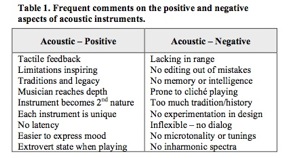
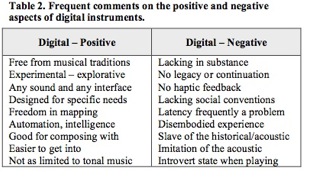
In order to build a play space for adolescents within the hospital environment it is important to understand the difference between the traditional tools used by therapists and patients and how digital technologies may benefit stimulation and distraction techniques within the hospital environment by remediating the acoustic instrument to digital design (Kendrick, 1993). Two examples of tools remediating the acoustic instrument using physical and musical parameters are EAMIR Floor Tiles and QFWFQ Duo’s work Disconcertio.
The interactive floor tiles by sound design artist Vince Manzo of EAMIR, (Manzo V.J, 2010) is a solid example of an interactive digital instrument that could be used in a play setting (see Figure 3 ). The floor tiles are simplistic and the relationship between the user and the device is clear – for example, if you apply pressure to a floor tile, a single sound is triggered. The response however is limited. There is no change in nuance and the cause and effect of the device is the same for all individuals who use it. This raises questions as to how long this simple device would stimulate a teenager. It could be gathered that the stimulation of the device would not be long.
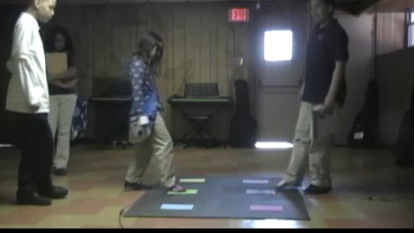
QFWFQ Duo (QFWFQ Duo, 2007) however, differs from Mano’s Floor Tiles. Common elements in QFWFQ Duo’s artistic language are: interactivity, which is treated as an expressive parameter in itself, projected images, electronic sound, voice, movements and / or actions. These elements are closely related to one another and the relationships are constantly changing. QFWFQ Duo’s work Disconcertio is vastly different to Floor Tiles as the piece is audio-visual. The piece involves interaction between a torchlight and video tracking. The relationship between the user and the device is not immediately clear and could be considered dynamic. Therefore, the stimulation potential of this device could be longer as it takes longer to learn, the relationship of the device is not clear and the piece is nuanced to suit each individual.
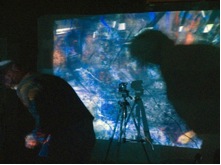
The challenge with design considerations for the Music Cubes is not making the interactive components too simple, as they will not be stimulating, or too hard, as the device would be too difficult to use. It would be beneficial therefore, to design the Music Cubes to offer both components – simple interaction and the opportunity for more dynamic play. This could be achieved through the use of triggering sound samples, by assigning different instruments to each individual cube therefore allowing the participant to develop a composition or alternatively, allow for the interaction of up to three players, each taking one particular cube assigned to a particular instrument (for example, one cube could be bass, another drums). This can also encourage socialising and normalising among patients.
Conclusions
Play is important in distracting patients during potentially distressing procedures. This can be achieved in a number of ways depending on the patient’s age, their developmental level, the procedure they are enduring and their anxiety level.
In order to build a successful interactive device for adolescents within the hospital environment, it is important to understand the difference between the traditional tools used to distract patients, for example Play Stations and iPods. This can contribute to an understanding of how digital technologies may benefit stimulation and distraction techniques within the hospital environment by remediating the acoustic instrument to digital design (Kendrick, 1993).
There are many new interfaces and computer devices that are being created that can incorporate art, music, play and technology within the one model. The hospital environment is merely scratching the surface of an incredible, adaptable and beneficial tool. Technology tends to only be limited by our imaginations, which can sometimes be scary (to those who don't understand its applications), but also has the potential to do many great things socially, mentally and in other cases, physically. In the future, technology could be integrated with existing play tools to support educational, therapeutic, and assessment outcomes in the areas of communication, social and self-esteem development. This project proposes a solution, if merely a small one, towards the lack of innovative stimulation for teenage patients of the Adolescent Medicine Department at The Children’s Hospital Westmead.
References
C Preti, & G Welch. (2004). Music in a hospital setting: a multifaceted experience. British Journal of Music Education 21(1), 329-345.
C Tam, H Schwellnus, C Eaton, Y Hamdani, & A Lamont T Chau. (2007). Movement-to-music computer technology: a developmental play experience for children with severe physical disabilities. Occupational Therapy International Jouran, 14(2), 99-112.
D Rode, K Capitulo, M Fishman, & G Holden. (1998). The Therapeutic Use of Technology American Journal of Nursing, 98 (12), 32-35.
D Salonius-Pasternak, & H Gelfond. (2005). The next level of research on electronic play: Potential benefits and contestual influences for children and adolescents. Interdisciplinary Journal on Humans in ICT Enviroments, 1(1), 5-22.
Estreich K. (2010). Personal Communication: Royal Randwick Childrens Hospital.
Health NSW. (2004). Schools Physical Activity and Nutrition Survey. Retrieved 11/06/2010, from http://www.health.nsw.gov.au/pubs/2006/pdf/spans_report.pdf
Hubbuck C. (2009). Play for Sick Childern: Play Specialists in Hospitals and Beyond. Great Britian: JKP Publishing.
Kendrick, M. (1993). Interactive Technology and the Remediation of the Subject of Writing. Configurations, 9(2), 231-251.
Lime. (2010). Lime Offical Website. Retrieved 24/05/2010, from http://www.limeart.org/about.html
Magee W Burland K (2008). An Exploratory Study of the Use of Electronic Music Technologies in Clinical Music Therapy. Nordic Journal of Music Therapy, 17(2), 124-141.
Manzo V.J. (2010). EAMIR Offical Website. Retrieved 19/03/2010, 2010, from http://www.eamir.org
N Anderson. (2010). Meeting at Westmead Childrens Hospital. In S. Ewart & G Paine (Eds.). Westmead.
P Carreras, A Durany, J Jaume Ferrer, J Pere Freixa, P David Gómez, D Kruglanski, et al. (2006). MEDIATE: An interactive multisensory environment for children with severe autism and no verbal communication., 9. Retrieved from http://www.iua.upf.es/eic
Paine G. (2009). Towards unified design guidelines for new interfaces for musical expression. Organized Sound.
QFWFQ Duo. ( 2007). Desconcierto pt2. Paper presented at the New Interfaces for Musical Expression.
Sony Computer Entertainment. (2010). Sony Playstation. Retrieved 26/05/2010, from http://au.playstation.com/
Stack Games. (2009). Wii-hab- has the Wii made everyone healthy? JB HI-FI, 88,89.
Stagnitti, K. (2004). Understanding play: The implications for play assessment
. Australian Occupational Therapy Journal, 51, 3-12.
T. Magnusson, & E Mendieta. (2007). The acoustic, the digital and the body: A survey on musical instrument. Conference on New Interfaces for Musical Expression (1-6).
The Department of Adolescent Medicine. (2008). Teenscape: A backyard odessey Unpublished Mural. Youth Arts Program.
The Starlight Children's Foundation. (2010). Club Aldo. Retrieved 07/05/2010, from http://www.starlight.org.au/OurPrograms/Pages/ClubAdo.aspx
Urban, R. (2005, April 13th, 2005). Wiggles have the whole World in their hands. Sydney Morning Herald. Retrieved from http://www.theage.com.au/news/Business/Wiggles-have-whole-World-in-their-hands/2005/04/12/1113251625530.html
Westmead Children's Hospital. (2010). The Starlight Childrens Foundation. Retrieved 01/03/2010, from http://www.chw.edu.au/kids/starlight/
Yahoo! (2005). Truly, madly, deeply engaged: Global youth, media and technology. OMD Retrieved 11/06/2010, from http://www.gettingconnected.org.au/youth-statistics
About the Author
Samantha Ewart has recently completed her Honours degree at the University of Western Sydney. The degree fused music, composition and digital technology to act as a therapeutic distraction to teenage patients in hospital. The project was completed in collaboration with the Department of Adolescent Medicine, at the Children's Hospital Westmead. In 2009 she completed a Bachelor of Music majoring in Digital Technology. In the same year she was awarded the Turramurra Technology Prize for academic achievement. She has a strong interest in the integration of technology and music into therapeutic practices within the medical field.
Project website: http://vipre.uws.edu.au/interactiveMusic/Welcome.html
Contact: samanthaewart@hotmail.com